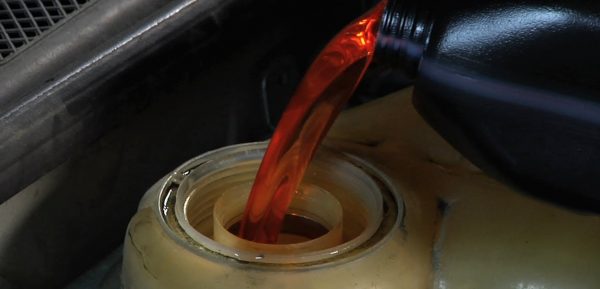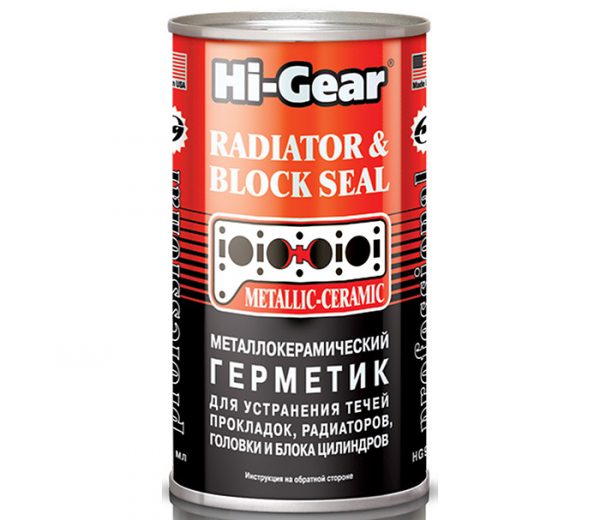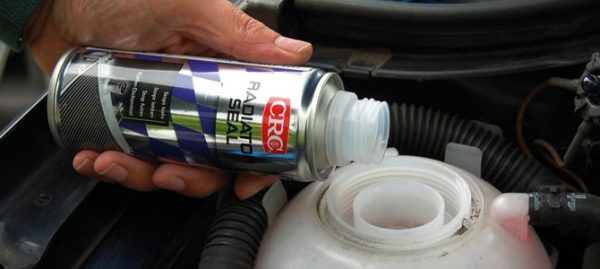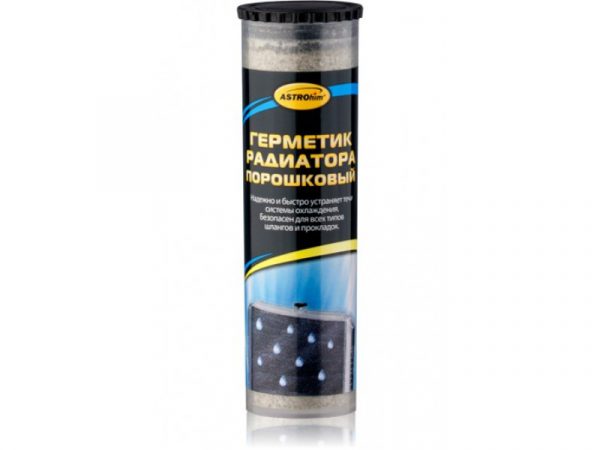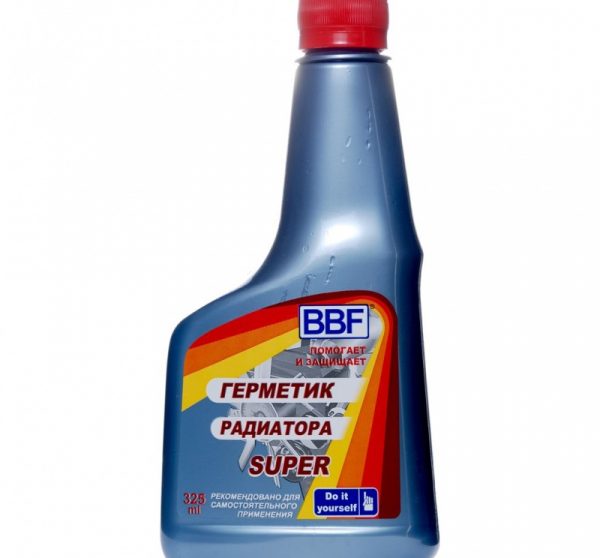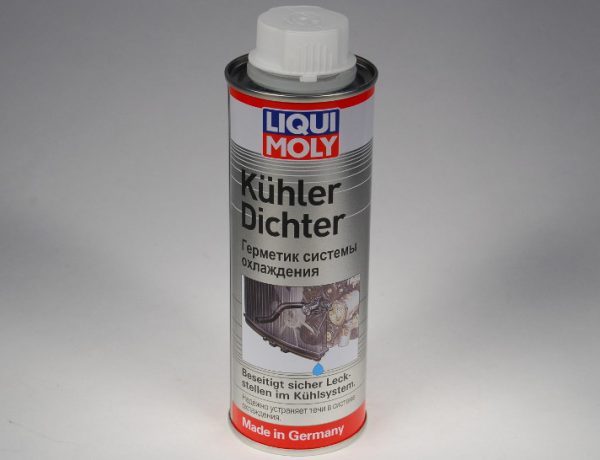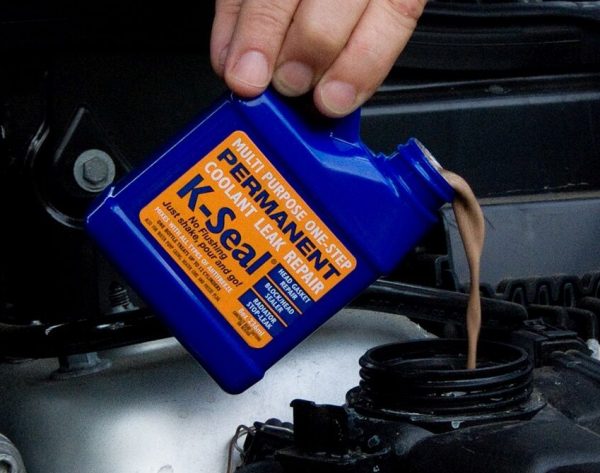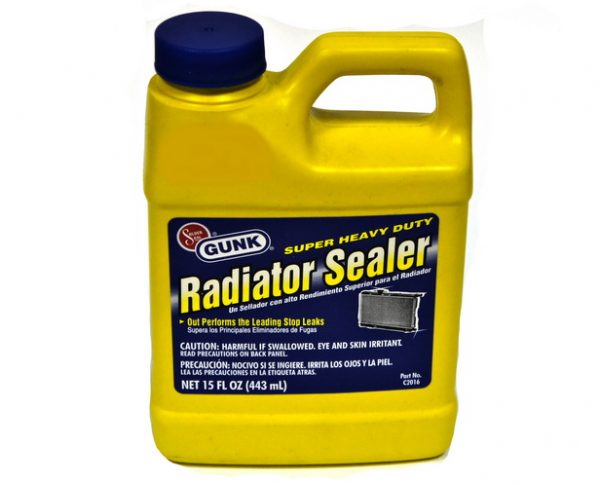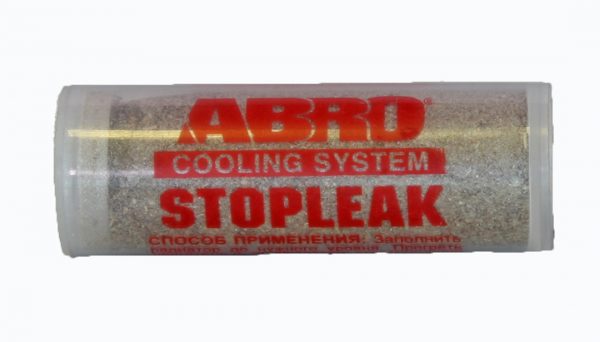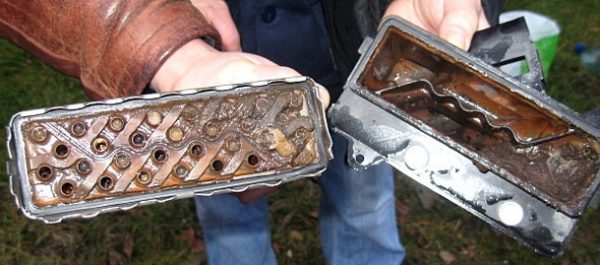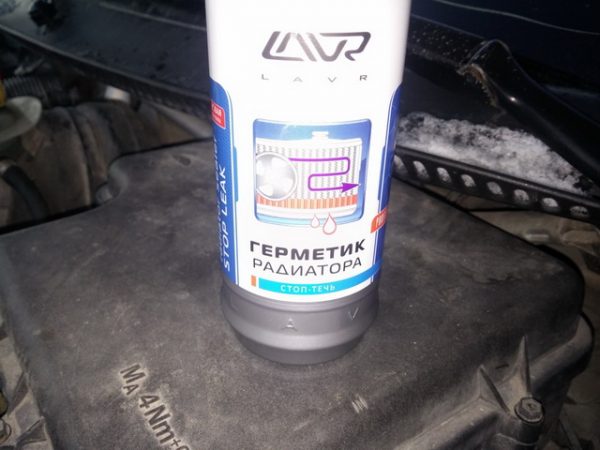A car radiator leak is a situation requiring repair in a short time. Typically, the cause of the problem is metal wear, which is caused by constant temperature changes in the cooling system. To eliminate leaks, you can use a special sealant for the radiator. It is ideal if the hole is small and the nearest car service is far away.
- Sealant History
- Purpose and Compatibility
- Release form and articles
- Sealant action
- Types of sealants for the radiator
- Sealant rating for radiator
- BBF Super
- Liqui Moly Kuhler Dichter
- K-seal
- Hi-Gear Radiator Stop Leak
- Gunk Radiator Sealer Super
- Fill inn
- Other types of sealants
- Pros and cons of using sealants
- How to flush the radiator from sealant
- Possible problems
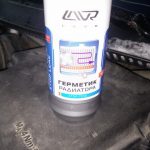
Sealant History
Before the first specialized compound was made to repair a radiator leak, car owners had to be more inventive. To get rid of the holes, tobacco or mustard was added to the system. For example, this method was widely practiced during the Afghan war. If you pour mustard into it, pour in water, you could drive at least 300 km, which was usually enough to reach the maintenance point.
to contents ↑The minus of the “mustard” repair was significant: I had to change the radiator, because it was unrealistic to completely rinse the cells from the yellow precipitate. Gradually, the chemical industry began to produce compounds that were more suitable for eliminating leaks and were less dangerous - sealants.
Purpose and Compatibility
All sealants for radiators have only one purpose - sealing microcracks in the cooling system. They seal elements of the system, soldering zones, joints. In addition to restoring the integrity of the radiator, sealants eliminate leakage through the thermostat gasket, pump, hoses, tubes, and improve valve sealing. High-quality sealants are gas-resistant, suitable for all metals and plastic, combined with water, antifreeze, antifreeze.
There are metal sealants on sale - they can be used both to repair the cooling system, and to eliminate problems in the engine cylinders, interior heaters. Such products may only be added to water - they do not work in antifreeze, but after curing, absolutely any liquid is poured into the cooling system.
Another type of sealant is ceramic-metal compounds. They are widely used by professionals in auto repair shops and are suitable for repairing major damage. Ceramic fibers provide increased strength, so after repair the car will work for a rather long time, and you can wait a while to replace the radiator.
to contents ↑Release form and articles
Sealants are produced in the following forms with the corresponding marking:
| Name | vendor code | Volume ml |
|---|---|---|
| Standard sealant for cooling system | Hg9025 | 325 |
| HG9029 | 444 | |
| Metal sealant for cooling system | Hg9072 | 946 |
| HG9037 | 325 | |
| Monophasic metal sealant for a radiator | Hg9048 | 236 |
| Ceramic-metal sealant against leaks in the cooling system | HG9043 | 444 |
| Ceramic-metal sealant for cooling system repair | Hg9041 | 325 |
Sealant action
Should sealants be poured into the system, are they reliable? Such compositions have a unique method of application: if they get into the crack and come into contact with the liquid inside the tank, they begin to solidify, becoming a cork. Such a “patch” does not dissolve, does not spread, therefore, fluid leakage is eliminated.
Sealants after polymerization are not subject to the negative effects of temperature changes, vibration, they work no worse than welds. If we consider the ceramic-metal sealant, then when it comes in contact with air, it expands a little, moreover, it is very durable. This helps the composition reliably eliminate even severe leaks.
to contents ↑Types of sealants for the radiator
Conventional silicone sealants used in plumbing work are not suitable for repairing the cooling system. It uses specialized tools that are divided into such groups:
- Powder They have the lowest cost, usually available in small packages for a single application. Designed to eliminate minor defects (up to 1 mm). Powder sealants have a significant drawback - they lead to the appearance of sediment in the radiator, as well as clog the system throughout its length.
- Liquid. More expensive products, often containing metallic particles. They are used to repair the cooling system in the presence of small and medium leaks. Sealants remain in antifreeze and are removed only when it is replaced.
- Polymer. A type of liquid sealant having a modern composition with polymer particles. The latter penetrate the cracks, reliably sticking them. Sealants of this group are suitable for the repair of large leaks.
Sealant rating for radiator
How to choose the best cooling system sealant? According to users and auto repair shops, it’s not worth saving, it is recommended to choose a tool from the list of the highest quality from reliable manufacturers. A number of sealants, despite their fame, have negative properties that also need to be taken into account.
BBF Super
This radiator sealant leads in many ratings. It quickly clogs cracks in the cooling system, after application in just 20 seconds, a durable joint is formed. The latter is a polymer plug that does not release antifreeze from the system. The tool is suitable for such materials:
- steel;
- cast iron;
- plastic;
- titanium;
- aluminum;
- rubber;
- alloys.
to contents ↑The sealant for the car radiator is applied after the engine has cooled down in a convenient way: it is added to the expansion tank or the radiator itself. After starting the motor, small holes will be closed with a dried product, while residual deposits appear in a minimum amount.
Liqui Moly Kuhler Dichter
This is another liquid sealant that can be used to repair a radiator in the presence of small to medium damage. With it, you can really protect the engine from coolant. The sealant is suitable only for aluminum and plastic, as well as systems in which water filters operate.
The tool has a number of features in use. If most sealants need to be used when the stove has stopped heating, then Liqui Moly Kuhler Dichter should be filled with the stove turned on. The engine during application of the composition is also required to idle for at least 10 minutes. The sealant closes holes very quickly and efficiently, removes leaks, but has a minus - it leads to the appearance of sedimentary powder.
to contents ↑K-seal
The specified sealant for the engine cooling system has less high user ratings for curing speed. He needs at least 75 seconds to close a 0.3 mm crack. You can not find it in every car shop, in addition, the price is quite high.
to contents ↑The composition of the product contains copper powder, coupled with polymers forming a strong “patch” in the leak. The sealant can be used without fear: it does not precipitate powder after solidification, it does not corrode elements of the cooling system and engine, and is suitable for all types of antifreeze and antifreeze.
Hi-Gear Radiator Stop Leak
The tool is designed to work with aluminum, copper, rubber, plastic elements, suitable for repairing the cooling system. Hi-Gear Radiator Stop Leak is used both for adding to antifreeze and to ordinary water. The sealant is used in the standard way: it is poured directly into the coolant into the radiator, then the engine is started for 5-7 minutes.
Unfortunately, HG sealant has several disadvantages:
- the need for flushing the radiator due to sediment;
- instability of chemical reactions, which are highly dependent on external factors, uneven gluing of cracks;
- low efficiency on medium and large holes.
Gunk Radiator Sealer Super
This effective sealant in the form of a thick brown emulsion is characterized by a high cure rate inside the cooling system. Before pouring, it is important to shake the product thoroughly, otherwise it may delaminate and work less efficiently. The sealant is suitable for emergency repairs, it equally quickly closes cracks of different sizes.
to contents ↑The disadvantages include the presence of a large number of deposits after application, which is bad for old, heavily clogged radiators. Due to the presence of certain substances in the composition, this sealant is harmful to humans. You must work with it with extreme caution, avoiding contact with the skin, mouth, eyes!
Fill inn
Sealants Filin professionals rarely use because of the length of time the formation of cork inside the radiator. In addition, it is suitable only for the smallest cracks (less than a millimeter) and gives a large amount of sediment. For many users, the determining factor is the low price of the material, as well as safety for all cooling systems, compatibility with any liquids, therefore this sealant is in demand.
to contents ↑Other types of sealants
If the specified funds were not in the store, you can pay attention to the following sealing compounds:
- Lavr Stop Flow. It is used in any cooling system, does not clog radiators, eliminates defects in pipes, thermostat and other elements, does not damage the pump.
- Abro Stop Leak. Dry sealant, can be used to eliminate leaks and for preventive purposes. The instruction indicates that it must be poured into the radiator, and then turn on the engine, as is done when working with liquid sealants.
- Runway. It mainly closes small cracks, solidifies quickly enough, it allows not to change the antifreeze completely, but simply to add it to the radiator.
- "Hera Auto". Powder sealant in a small package at the lowest price. Suitable for any chilled liquids, does not cause corrosion.
- "Triton". Excellent sealant, the volume of which is enough for 8 liters of liquid. It freezes quite quickly - in a few minutes.
- Sintec. It has a minimum consumption, inexpensive, but is able to clog radiators on older cars.
Pros and cons of using sealants
Automotive sealants for radiators have obvious advantages, and the most important of them is the ability to get to the repair shop, keeping the motor from overheating. They are ideal as an emergency measure when there is no way to call a tow truck. It is not necessary to smear the radiator walls with sealants, they are simply poured into the system, which is very fast and convenient.
However, sealant is only a temporary solution. Any tool to different degrees clogs the system, reduces the efficiency of its work, reduces the service life of nodes. Therefore, it is necessary to wash the radiator as soon as possible in order to remove residual sealant and sediment. In any case, it is cheaper to replace engine parts, which will have to be done after overheating. Another disadvantage is the inability to eliminate too large holes: in some cases, you have to immediately make a mechanical repair.
to contents ↑
How to flush the radiator from sealant
To get rid of plaque, which can form on the internal surfaces of the cooling system, it is necessary to flush the radiator. For this purpose, special means are used, both folk and factory. The first include vinegar, citric acid, whey, caustic soda. Among professional products, Hi-Gear, Lavr, Liqui Moly brands are used, which more effectively clean the radiator. It must be remembered that with high-quality cleaning, sealed “patches” are also removed, so the system must be fully repaired.
to contents ↑Possible problems
It happens that the sealant turns out to be base or completely fake, so instead of closing the crack, you can get:
- clogging of thin radiator tubes;
- violation of engine cooling, its overload and breakdown;
- clogged radiator stove; violation of interior heating;
- failure of the pump, thermostat.
To avoid this, you need to purchase sealing compounds of reliable manufacturers, after consulting with the seller, and also apply them strictly according to the instructions. This will help to temporarily solve the radiator leak problem and get to the repair shop without consequences.

